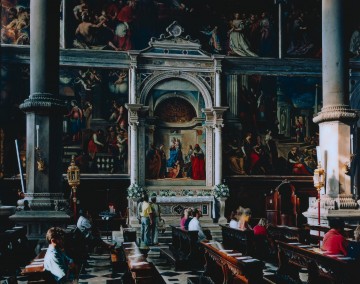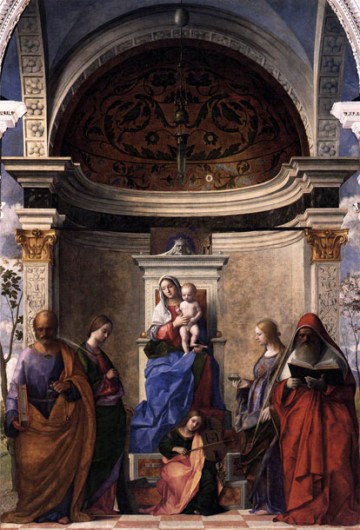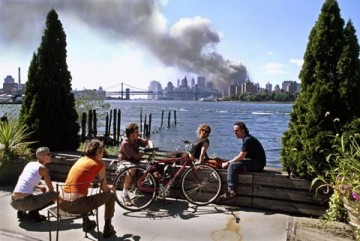
Thomas Struth, "San Zaccaria," 1995. Image courtesy the Metropolitan Museum of Art, New York. Purchase, The Howard Gilman Foundation Gift, 1996 (1996.297) © Thomas Struth.
Maybe Thomas Struth’s 1995 photograph of the interior of the church of San Zaccaria in Venice is too obvious a way to epitomise the relationship between contemporary art and the art of the past. Not only that: it’s also nearly 20 years old, it’s over-familiar, and it’s representative of a moment in photography that now looks old hat, very pre-2008. The thing itself seems like a relic of a time when photography set out to be object first and image second: a huge glossy C-print, designed for easy installation over a plutocrat’s mantle. There’s something obscene about it, even: a photographic object, printed in an edition made to sate commercial tastes, recording a unique painted object, whose placement – as much as whose content and author – generates a heightened aura of sacramental exclusivity. There’s pathos to that, too, on first look. It might be used to head an article on the indifference of the modern public to great artistic masterpieces (look at that dude on the bottom left! He’s not even looking!), or an op-ed on the rise of atheism. So the reaction to the work is sometimes a bit sneering. That, or – as I witnessed while looking at this work in Struth’s current show at the Whitechapel gallery – awe. Strewth!
If the response to the image is so often one of wonder, it’s in reaction to the church interior itself. On being looked at, the photograph removes itself, like a pane of glass in a window. (Its size, which is enveloping and vision-filling, is a part of this: not seeing the parenthetical white wall around the photograph is an easy way of stepping in). There are discontinuities and un-picturesque bits in Struth’s image that look unintentional: the arbitrary scattering of visitors, for instance, which on closer inspection reveal themselves to be part of a pattern that locks together the image-in-the-image, the image, and the world of the observer. Look at how those tourists sitting in the pews – contemplating the last of their currency, or the best time to leave for the airport – become correlatives of the painted figures behind them. Not the main narrative events, like the young Mary ascending the steps of the temple, or the saints gravely reading the sacred texts, but the peripheral characters, the mechanicals: the startled onlookers, gesticulating dumbly to something they don’t quite understand. (There’s a cropped painted figure in the top right of the photograph, for instance, that appears to mimic a seated figure in the pews directly below, and there are plenty of other serendipitous pairings). The whole image, then, becomes about the condition of being peripheral to a main event, like an illustration of Auden’s poem about Breughel’s Fall of Icarus (“it takes place/While someone else is eating or opening a window”). Bellini’s Mary is still at dead center, more or less at eye-level, and the altarpiece contains its own centrifugal hierarchy, from Madonna and child to saints to slivers of landscape beyond, which in turn sits in the center of a wall of pretty B-league later painting, which in turn is observed by real visitors (and us, of course), with the entire composition locked together by the two piers, cousins of Bellini’s real, and painted, versions. There are main events, and there are onlookers. (The photograph below, by Thomas Hoepker, enacts a similar centralised event/centrifuged onlookers tension, with very different results; the main event still holds the perspectival center ground). Struth’s photograph is a parable about history, using art history as its metaphor.
Struth’s image illustrates a notion that is key to unpacking art’s relationship to its own past. Beyond the niceties of art history (and I’ve been in this church many times with groups of teenagers, feeling the eyes in Bellini’s painting bore holes in the back of my skull, while trying to explain terms like “perspective” and “symbolism” that seem posthumous and petty in relation to such a painting), what makes art most come alive – what makes it most justify its reasons for being, beyond being an academic ice-breaker or a mere product of its time, thrown up automatically in a kind of historical gag reflex – is the transferral of ideas. Struth’s photo demarcates the looker and the looked at, the main event and the audience, and in doing so makes a case in the only way it knows how – visually – for the real art history, which is something passed, hand to hand, from artist to artist, on and on.
____________________________________________________________________
I’m taking an extended sabbatical from Letter from London for the remainder of the year to focus on a number of educational, curatorial and writing projects, all of which will be previewed on my blog, here. Thanks for reading.





